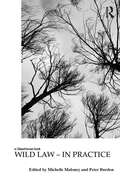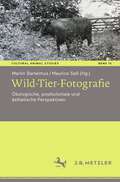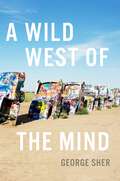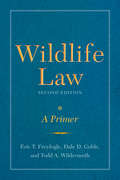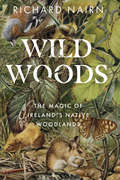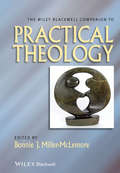- Table View
- List View
Wild Law - In Practice (Law, Justice and Ecology)
by Peter Burdon Michelle MaloneyWild Law - In Practice aims to facilitate the transition of Earth Jurisprudence from theory into practice. Earth Jurisprudence is an emerging philosophy of law, coined by cultural historian and geologian Thomas Berry. It seeks to analyse the contribution of law in constructing, maintaining and perpetuating anthropocentrism and addresses the ways in which this orientation can be undermined and ultimately eliminated. In place of anthropocentrism, Earth Jurisprudence advocates an interpretation of law based on the ecocentric concept of an Earth community that includes both human and nonhuman entities. Addressing topics that include a critique of the effectiveness of environmental law in protecting the environment, developments in domestic/constitutional law recognising the rights of nature, and the regulation of sustainability, Wild Law - In Practice is the first book to focus specifically on the practical legal implications of Earth Jurisprudence.
Wild Law - In Practice (Law, Justice and Ecology #4)
by Michelle Maloney Peter BurdonWild Law - In Practice aims to facilitate the transition of Earth Jurisprudence from theory into practice. Earth Jurisprudence is an emerging philosophy of law, coined by cultural historian and geologian Thomas Berry. It seeks to analyse the contribution of law in constructing, maintaining and perpetuating anthropocentrism and addresses the ways in which this orientation can be undermined and ultimately eliminated. In place of anthropocentrism, Earth Jurisprudence advocates an interpretation of law based on the ecocentric concept of an Earth community that includes both human and nonhuman entities. Addressing topics that include a critique of the effectiveness of environmental law in protecting the environment, developments in domestic/constitutional law recognising the rights of nature, and the regulation of sustainability, Wild Law - In Practice is the first book to focus specifically on the practical legal implications of Earth Jurisprudence.
Wild Life: The Institution of Nature
by Irus BravermanWild Life documents a nuanced understanding of the wild versus captive divide in species conservation. It also documents the emerging understanding that all forms of wild nature—both in situ (on-site) and ex situ (in captivity)—may need to be managed in perpetuity. Providing a unique window into the high-stakes world of nature conservation, Irus Braverman describes the heroic efforts by conservationists to save wild life. Yet in the shadows of such dedication and persistence in saving the life of species, Wild Life also finds sacrifice and death. Such life and death stories outline the modern struggle to define what conservation should look like at a time when the long-established definitions of nature have collapsed. Wild Life begins with the plight of a tiny endangered snail, and ends with the rehabilitation of an entire island. Interwoven between its pages are stories about golden lion tamarins in Brazil, black-footed ferrets in the American Plains, Sumatran rhinos in Indonesia, Tasmanian devils in Australia, and many more creatures both human and nonhuman. Braverman draws on interviews with more than one hundred and twenty conservation biologists, zoologists, zoo professionals, government officials, and wildlife managers to explore the various perspectives on in situ and ex situ conservation and the blurring of the lines between them.
Wild Romance: The True Story of a Victorian Scandal
by Chloë SchamaIn 1852, on a steamer from France to England, nineteen-year-old Theresa Longworth met William Charles Yelverton, a soldier destined to become the Viscount of Avonmore. Their flirtation soon blossomed into a clandestine, epistolary affair, and five years later they married secretly in Edinburgh. Then, that same summer, they married again in Dublin - or did they? Separated by circumstance soon after they were wed, Theresa and Charles would never live together as husband and wife. And when Yelverton married another woman, an abandoned Theresa found herself forced to prove the validity of her marriage. Multiple trials ensued, and the press and the public seized upon the scandal and reported its every detail with relish. Wild Romance is the inspiring tale of a woman who never gave up, and who held on to her ideals of independence, dignity and - despite everything - love.
Wild-Tier-Fotografie: Ökologische, postkoloniale und ästhetische Perspektiven (Cultural Animal Studies #15)
by Martin Bartelmus Maurice SaßTechnische Innovationen der Fotografie erlaubten Ende des 19. Jahrhunderts, Wildtiere nicht mehr nur als Kadaver und Beute oder in Studio und Gehege abzulichten, sondern ihnen in ihrem natürlichen Habitat nachzuspüren. Die frühe Wildtierfotografie bediente damit ein populäres Interesse an der als lokal, national oder kolonial geschätzten Fauna, lieferte wichtige Beiträge zur zoologischen Forschung und verstand sich häufig als Vorkämpfer des Naturschutzes. Ganz neu stellte sich damit aber auch die Frage, wie man Tiere richtig fotografiert: technisch, ästhetisch, ethisch. Der Band beantwortet diese Fragen in historischer Perspektive und erschließt damit das Forschungsfeld der Wildtierfotografie.
A Wild West of the Mind
by George SherCan unexpressed thoughts be morally wrong? Are people subject to moral condemnation not only for their malicious, biased, and cruel actions, but also for their private malice, biased beliefs, and ugly fantasies? Although many would answer "yes," George Sher argues in A Wild West of the Mind that none of the main approaches to morality support this view and that to accept it would be to relinquish an essential aspect of our mental freedom. To preserve that freedom, we must allow our beliefs to follow the evidence wherever it leads and must give our private feelings, attitudes, and fantasies free rein. As so understood, the realm of the purely mental is a morality-free zone, one within which no thoughts or attitudes are either forbidden or required. Even when our beliefs are irrational or repugnant and our desires reflect badly on our character, it is never morally wrong for us to have them. A Wild West of the Mind advances a provocative thesis of normative ethics and offers a powerful defense of freedom of mind. Broad in scope and tightly argued, the book will have much to offer philosophers working in ethics, free will, and epistemology.
A Wild West of the Mind
by George SherCan unexpressed thoughts be morally wrong? Are people subject to moral condemnation not only for their malicious, biased, and cruel actions, but also for their private malice, biased beliefs, and ugly fantasies? Although many would answer "yes," George Sher argues in A Wild West of the Mind that none of the main approaches to morality support this view and that to accept it would be to relinquish an essential aspect of our mental freedom. To preserve that freedom, we must allow our beliefs to follow the evidence wherever it leads and must give our private feelings, attitudes, and fantasies free rein. As so understood, the realm of the purely mental is a morality-free zone, one within which no thoughts or attitudes are either forbidden or required. Even when our beliefs are irrational or repugnant and our desires reflect badly on our character, it is never morally wrong for us to have them. A Wild West of the Mind advances a provocative thesis of normative ethics and offers a powerful defense of freedom of mind. Broad in scope and tightly argued, the book will have much to offer philosophers working in ethics, free will, and epistemology.
Wildfire and Power: Policy and Practice (Routledge Studies in Employment and Work Relations in Context)
by Peter Fairbrother Meagan TylerThis book brings together perspectives from sociology, political science, gender studies, and history to produce new ways of analysing wildfire preparedness and policy in Australia. Drawing on data from hundreds of interviews with residents, volunteers and emergency services professionals living and working in wildfire-prone areas, the authors focus on issues of power and inequality, the contested nature of community and the relationship between citizens and the state. The book questions not only existing policy approaches, but also the central concepts on which they are founded. In doing so, the aim is to create a more conceptually robust and academically contextualised discussion about the limitations of current wildfire policy approaches in Australia and to provide further evidence of the need for disaster studies to engage with a variety of social science approaches. Wildfire and Power: Policy and Practice will be of most interest to higher degree by research students, other academics and policy makers examining the evolving patterns and politics of work, employment, management and industrial relations as well as those involved in emergency and disaster management service delivery. It would be most suited to academic and public libraries as well as organisations in the field of emergency and disaster management.
Wildfire and Power: Policy and Practice (Routledge Studies in Employment and Work Relations in Context)
by Peter Fairbrother Meagan TylerThis book brings together perspectives from sociology, political science, gender studies, and history to produce new ways of analysing wildfire preparedness and policy in Australia. Drawing on data from hundreds of interviews with residents, volunteers and emergency services professionals living and working in wildfire-prone areas, the authors focus on issues of power and inequality, the contested nature of community and the relationship between citizens and the state. The book questions not only existing policy approaches, but also the central concepts on which they are founded. In doing so, the aim is to create a more conceptually robust and academically contextualised discussion about the limitations of current wildfire policy approaches in Australia and to provide further evidence of the need for disaster studies to engage with a variety of social science approaches. Wildfire and Power: Policy and Practice will be of most interest to higher degree by research students, other academics and policy makers examining the evolving patterns and politics of work, employment, management and industrial relations as well as those involved in emergency and disaster management service delivery. It would be most suited to academic and public libraries as well as organisations in the field of emergency and disaster management.
Wildfire Arson Prevention Guide
by Richard Woods, AFSMWildfire arson is often considered an impossible crime to solve. Likewise, offenders frequently consider themselves undetectable. Many agencies often do not have the specialist skills necessary to investigate those responsible for serial wildfire ignitions. As such, perpetrators continue to light fires with little to no likelihood of being caught. An ongoing series of deliberately lit wildfires can result in significant financial and environmental consequences and put life and property at risk. This Wildlife Arson Prevention Guide provides law enforcement, land management and fire agency investigators with frameworks, strategies and tactics—that can be adopted to address deliberate wildfire ignitions in their jurisdiction. Often this crime is automatically given to law enforcement agencies to solve in isolation, whereas a collaborative approach across key agencies has proven essential in apprehending offenders. This valuable guidebook fills a void in the literature, detailing a collaborative approach through the adoption of successful best practice investigation techniques. Many may be applicable to—and better serve—smaller rural communities, while others can be adopted in more populated wildfire-prone areas. This book recognises that some small rural agencies may have less capacity to address the issue and may need to modify the recommended methods; ideally, the text encourages the establishment of collaborative arrangements to work with larger or adjoining agencies, to help solve their serial wildfire arson cases. This book highlights successfully adopted measures that can be embraced by key agencies that have a responsibility in wildfire ignition prevention. Currently, no similar all-encompassing handbook exists to guide agencies to address this growing worldwide problem. The strategies and tactics are presented in a format that can be easily aligned to jurisdictions within countries that are at risk of wildfire. The commonly recognised motives behind wildfire arson are detailed to provide agency investigators with a background to this often-misunderstood offence. The Wildlife Arson Prevention Guide provides the tools that will help authorities to identify those responsible and result in stronger, safer communities.
Wildfire Arson Prevention Guide
by Richard Woods, AFSMWildfire arson is often considered an impossible crime to solve. Likewise, offenders frequently consider themselves undetectable. Many agencies often do not have the specialist skills necessary to investigate those responsible for serial wildfire ignitions. As such, perpetrators continue to light fires with little to no likelihood of being caught. An ongoing series of deliberately lit wildfires can result in significant financial and environmental consequences and put life and property at risk. This Wildlife Arson Prevention Guide provides law enforcement, land management and fire agency investigators with frameworks, strategies and tactics—that can be adopted to address deliberate wildfire ignitions in their jurisdiction. Often this crime is automatically given to law enforcement agencies to solve in isolation, whereas a collaborative approach across key agencies has proven essential in apprehending offenders. This valuable guidebook fills a void in the literature, detailing a collaborative approach through the adoption of successful best practice investigation techniques. Many may be applicable to—and better serve—smaller rural communities, while others can be adopted in more populated wildfire-prone areas. This book recognises that some small rural agencies may have less capacity to address the issue and may need to modify the recommended methods; ideally, the text encourages the establishment of collaborative arrangements to work with larger or adjoining agencies, to help solve their serial wildfire arson cases. This book highlights successfully adopted measures that can be embraced by key agencies that have a responsibility in wildfire ignition prevention. Currently, no similar all-encompassing handbook exists to guide agencies to address this growing worldwide problem. The strategies and tactics are presented in a format that can be easily aligned to jurisdictions within countries that are at risk of wildfire. The commonly recognised motives behind wildfire arson are detailed to provide agency investigators with a background to this often-misunderstood offence. The Wildlife Arson Prevention Guide provides the tools that will help authorities to identify those responsible and result in stronger, safer communities.
Wildlife as Property Owners: A New Conception of Animal Rights
by Karen BradshawHumankind coexists with every other living thing. People drink the same water, breathe the same air, and share the same land as other animals. Yet, property law reflects a general assumption that only people can own land. The effects of this presumption are disastrous for wildlife and humans alike. The alarm bells ringing about biodiversity loss are growing louder, and the possibility of mass extinction is real. Anthropocentric property is a key driver of biodiversity loss, a silent killer of species worldwide. But as law and sustainability scholar Karen Bradshaw shows, if excluding animals from a legal right to own land is causing their destruction, extending the legal right to own property to wildlife may prove its salvation. Wildlife as Property Owners advocates for folding animals into our existing system of property law, giving them the opportunity to own land just as humans do—to the betterment of all.
Wildlife as Property Owners: A New Conception of Animal Rights
by Karen BradshawHumankind coexists with every other living thing. People drink the same water, breathe the same air, and share the same land as other animals. Yet, property law reflects a general assumption that only people can own land. The effects of this presumption are disastrous for wildlife and humans alike. The alarm bells ringing about biodiversity loss are growing louder, and the possibility of mass extinction is real. Anthropocentric property is a key driver of biodiversity loss, a silent killer of species worldwide. But as law and sustainability scholar Karen Bradshaw shows, if excluding animals from a legal right to own land is causing their destruction, extending the legal right to own property to wildlife may prove its salvation. Wildlife as Property Owners advocates for folding animals into our existing system of property law, giving them the opportunity to own land just as humans do—to the betterment of all.
Wildlife as Property Owners: A New Conception of Animal Rights
by Karen BradshawHumankind coexists with every other living thing. People drink the same water, breathe the same air, and share the same land as other animals. Yet, property law reflects a general assumption that only people can own land. The effects of this presumption are disastrous for wildlife and humans alike. The alarm bells ringing about biodiversity loss are growing louder, and the possibility of mass extinction is real. Anthropocentric property is a key driver of biodiversity loss, a silent killer of species worldwide. But as law and sustainability scholar Karen Bradshaw shows, if excluding animals from a legal right to own land is causing their destruction, extending the legal right to own property to wildlife may prove its salvation. Wildlife as Property Owners advocates for folding animals into our existing system of property law, giving them the opportunity to own land just as humans do—to the betterment of all.
Wildlife as Property Owners: A New Conception of Animal Rights
by Karen BradshawHumankind coexists with every other living thing. People drink the same water, breathe the same air, and share the same land as other animals. Yet, property law reflects a general assumption that only people can own land. The effects of this presumption are disastrous for wildlife and humans alike. The alarm bells ringing about biodiversity loss are growing louder, and the possibility of mass extinction is real. Anthropocentric property is a key driver of biodiversity loss, a silent killer of species worldwide. But as law and sustainability scholar Karen Bradshaw shows, if excluding animals from a legal right to own land is causing their destruction, extending the legal right to own property to wildlife may prove its salvation. Wildlife as Property Owners advocates for folding animals into our existing system of property law, giving them the opportunity to own land just as humans do—to the betterment of all.
Wildlife as Property Owners: A New Conception of Animal Rights
by Karen BradshawHumankind coexists with every other living thing. People drink the same water, breathe the same air, and share the same land as other animals. Yet, property law reflects a general assumption that only people can own land. The effects of this presumption are disastrous for wildlife and humans alike. The alarm bells ringing about biodiversity loss are growing louder, and the possibility of mass extinction is real. Anthropocentric property is a key driver of biodiversity loss, a silent killer of species worldwide. But as law and sustainability scholar Karen Bradshaw shows, if excluding animals from a legal right to own land is causing their destruction, extending the legal right to own property to wildlife may prove its salvation. Wildlife as Property Owners advocates for folding animals into our existing system of property law, giving them the opportunity to own land just as humans do—to the betterment of all.
Wildlife Ecotoxicology: Forensic Approaches (Emerging Topics in Ecotoxicology)
by John E. Elliott, Christine A. Bishop and Christy A. MorrisseyMany books have now been published in the broad field of environmental toxicology. However, to date, none of have presented the often fascinating stories of the wildlife science, and the steps along the way from discovery of problems caused by environmental pollutants to the regulatory and non-regulatory efforts to address the problems. This book provides case by case examinations of how toxic chemical effects on wildlife have brought about policy and regulatory decisions, and positive changes in environmental conditions. Wild animal stories, whether they are about the disappearance of charismatic top predators, or of grossly deformed embryos or frogs, provide powerful symbols that can and have captured the public's imagination and have resulted in increased awareness by decision makers. It is the intent of this book to present factual and balanced overviews and summaries of the science and the subsequent regulatory processes that followed to effect change (or not). We cover a variety of chemicals and topics beginning with an update of the classic California coastal DDT story of eggshell thinning and avian reproduction to more recent cases, such as the veterinarian pharmaceutical that has brought three species of Asian vultures to the brink of extinction. Researchers, regulators, educators, NGOs and the general public will find valuable insights into the processes and mechanisms involved both in environmental scientific investigation and in efforts to effect positive change.
Wildlife Forensic Investigation: Principles and Practice
by John E. Cooper Margaret E. CooperWildlife forensics is the application of forensic science to the conservation and protection of non-domesticated animals, both in the wild and in captivity. Providing an in-depth introduction to this rapidly evolving field, Wildlife Forensic Investigation: Principles and Practice also chronicles aspects of the history of management, conservation, a
Wildlife Law: A Primer
by Eric T. Freyfogle Dale D. Goble Todd A. WildermuthTen years ago, Wildlife Law: A Primer was the first‑ever published survey of wildlife law for lay readers. Since its publication, the legal terrain has increased in complexity and the stakes are higher than ever. As humans encroach further into wildlife habitat, unwanted human‑wildlife interactions are occurring more frequently, sometimes with alarming and tragic outcomes. This revised and expanded second edition retains basic legal concepts from the first edition while offering new chapters that cover new controversial topics such as private wildlife reserves, game ranches, and nuisance species. It also includes expanded coverage of the Endangered Species Act. This is a groundbreaking reference for students in wildlife programs, land owners, and wildlife professionals.
Wildlife Trafficking: A Deconstruction of the Crime, Victims and Offenders (Critical Criminological Perspectives)
by Tanya WyattThis book provides a comprehensive, global exploration of the scale, scope, threats, and drivers of wildlife trafficking from a criminological perspective. Building on the first edition, it takes into account the significant changes in the international context surrounding these issues since 2013. It provides new examples, updated statistics, and discusses the potential changes arising as a result of COVID-19 and the IPBES 2019 report. It also discusses the shift in trafficking ‘hotspots’ and the recent projects that have challenged responses to wildlife trafficking. It undertakes a distinctive exploration of who the victims and offenders of wildlife trafficking are as well as analysing the stakeholders who are involved in collaborative efforts to end this devastating green crime. It unpacks the security implications of wildlife trade and trafficking and possible responses and ways to combat it. It provides useful and timely information for social and environmental/life scientists, law enforcement, NGOs, and policy makers.
Wildwoods: The Magic of Ireland's Native Woodlands
by Richard NairnEcologist Richard Nairn has spent a lifetime studying – and learning from – nature. When an opportunity arose for him to buy a small woodland filled with mature native trees beside a fast-flowing river, he set about understanding all its moods and seasons, discovering its wildlife secrets and learning how to manage it properly.Wildwoods is a fascinating account of his journey over a typical year. Along the way, he uncovers the ancient roles of trees in Irish life, he examines lost skills such as coppicing and he explores new uses of woodlands for forest schools, foraging and rewilding. Ultimately, Wildwoods inspires all of us to pay attention to what nature can teach us.‘A book to inspire anyone who wants Ireland to grow more Irish trees.’ Michael Viney
The Wiley Blackwell Companion to Catholicism (Wiley Blackwell Companions to Religion)
by Frederick C. Bauerschmidt James J. Buckley Jennifer Newsome Martin Trent PomplunProvides a broad and deep survey of Roman Catholic life and thought, updated and expanded throughout The Wiley Blackwell Companion to Catholicism provides an authoritative overview of the history, doctrine, practices, and expansion of Catholicism. Written by a group of distinguished scholars, this comprehensive reference work offers an illuminating account of the global, historical, and cultural phenomena of Catholicism. Accessible chapters address central topics in the practice of Catholic theology and the development of doctrine, including God and Jesus Christ, creation and Church, the Virgin Mary, the sacraments, moral theology, eschatology, and more. Throughout the text, the authors illustrate the unity and diversity of Catholic life and thought while highlighting the ways Catholicism overlaps with, and transforms, other ways of living and thinking. Now in its second edition, The Wiley Blackwell Companion to Catholicism is fully updated to include recent developments in the study of Catholicism. Extensively revised and expanded chapters, many of which written by new authors, address contemporary issues such as theology and politics, environmentalism, and the clerical sexual abuse crisis. Entirely new chapters cover the early modern Church, the Bible in Catholic theology, the Eastern Catholic churches, liturgy, care for creation, the consecrated life, challenges for the Catholic Church, and more. An informed and engaging intellectual journey through the past and present of Roman Catholicism, The Wiley Blackwell Companion to Catholicism: Illustrates the diversity of modern Catholic life and thought Describes Catholics in different lands, including the Holy Land, India, Africa, Europe, the British Isles, Asia, Oceania, and the Americas Surveys spirituality and ecumenism, inter-religious dialog, Catholic schools and hospitals, art and the sciences, the Holy See, and other central Catholic institutions and practices Covers major eras in Catholic history, from the Scriptures and the early Church to Post-Modernity Features new material on diverse practices of Catholicism across cultures, the global dimensions of the Catholic Church, race and ethnicity, and Eastern Catholic ChurchesThe Wiley Blackwell Companion to Catholicism, Second Edition, is the ideal textbook for surveys classes on Catholicism and Catholic theology in Catholic, Protestant, and non-confessional colleges and universities. It is also an invaluable resource for scholars and general readers interested in broadening their knowledge of Catholicism.
The Wiley Blackwell Companion to Catholicism (Wiley Blackwell Companions to Religion)
by Frederick C. Bauerschmidt James J. Buckley Jennifer Newsome Martin Trent PomplunProvides a broad and deep survey of Roman Catholic life and thought, updated and expanded throughout The Wiley Blackwell Companion to Catholicism provides an authoritative overview of the history, doctrine, practices, and expansion of Catholicism. Written by a group of distinguished scholars, this comprehensive reference work offers an illuminating account of the global, historical, and cultural phenomena of Catholicism. Accessible chapters address central topics in the practice of Catholic theology and the development of doctrine, including God and Jesus Christ, creation and Church, the Virgin Mary, the sacraments, moral theology, eschatology, and more. Throughout the text, the authors illustrate the unity and diversity of Catholic life and thought while highlighting the ways Catholicism overlaps with, and transforms, other ways of living and thinking. Now in its second edition, The Wiley Blackwell Companion to Catholicism is fully updated to include recent developments in the study of Catholicism. Extensively revised and expanded chapters, many of which written by new authors, address contemporary issues such as theology and politics, environmentalism, and the clerical sexual abuse crisis. Entirely new chapters cover the early modern Church, the Bible in Catholic theology, the Eastern Catholic churches, liturgy, care for creation, the consecrated life, challenges for the Catholic Church, and more. An informed and engaging intellectual journey through the past and present of Roman Catholicism, The Wiley Blackwell Companion to Catholicism: Illustrates the diversity of modern Catholic life and thought Describes Catholics in different lands, including the Holy Land, India, Africa, Europe, the British Isles, Asia, Oceania, and the Americas Surveys spirituality and ecumenism, inter-religious dialog, Catholic schools and hospitals, art and the sciences, the Holy See, and other central Catholic institutions and practices Covers major eras in Catholic history, from the Scriptures and the early Church to Post-Modernity Features new material on diverse practices of Catholicism across cultures, the global dimensions of the Catholic Church, race and ethnicity, and Eastern Catholic ChurchesThe Wiley Blackwell Companion to Catholicism, Second Edition, is the ideal textbook for surveys classes on Catholicism and Catholic theology in Catholic, Protestant, and non-confessional colleges and universities. It is also an invaluable resource for scholars and general readers interested in broadening their knowledge of Catholicism.
The Wiley Blackwell Companion to Practical Theology (Wiley Blackwell Companions to Religion #73)
by Bonnie J. Miller-McLemoreThrough a series of essays contributed by leading experts in the field, The Wiley-Blackwell Companion to Practical Theology presents an introduction to practical theology as a major area of Christian study and practice, including an overview of its key developments, themes, methods, and future directions. The first comprehensive reference work to provide a survey, description and analysis of practical theology as an area of study A range of leading scholars in the field provide original contributions on the major areas, issues, and figures in practical theology Reviews an extensive range of methods for studying theology in practice, along with sub-disciplines in theological education such as pastoral care and preaching Covers developments in the discipline in a range of global contexts and distinct Christian traditions Shows how practical theology is relevant to everyday life
The Wiley Blackwell Companion to Practical Theology (Wiley Blackwell Companions to Religion #72)
by Bonnie J. Miller-McLemoreThrough a series of essays contributed by leading experts in the field, The Wiley-Blackwell Companion to Practical Theology presents an introduction to practical theology as a major area of Christian study and practice, including an overview of its key developments, themes, methods, and future directions. The first comprehensive reference work to provide a survey, description and analysis of practical theology as an area of study A range of leading scholars in the field provide original contributions on the major areas, issues, and figures in practical theology Reviews an extensive range of methods for studying theology in practice, along with sub-disciplines in theological education such as pastoral care and preaching Covers developments in the discipline in a range of global contexts and distinct Christian traditions Shows how practical theology is relevant to everyday life
